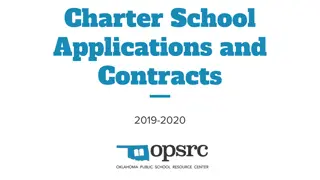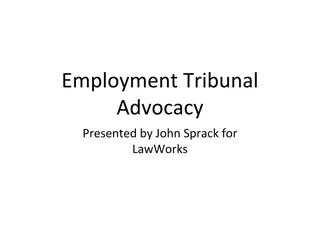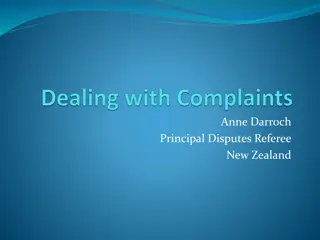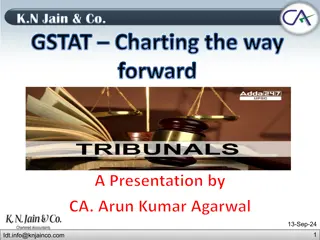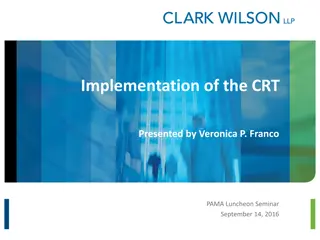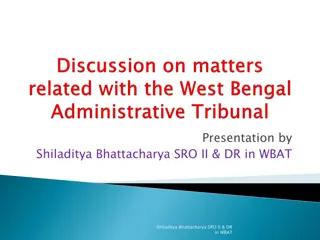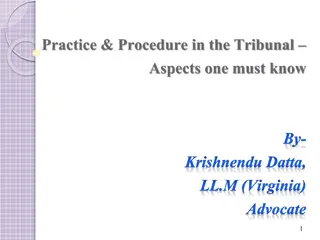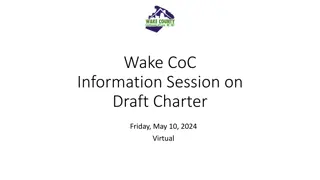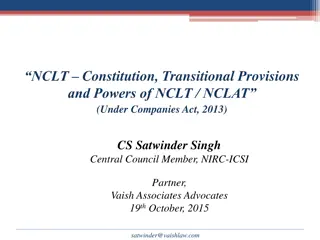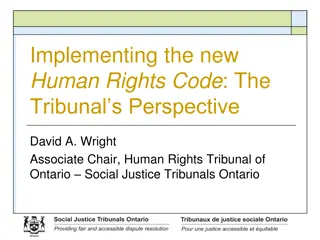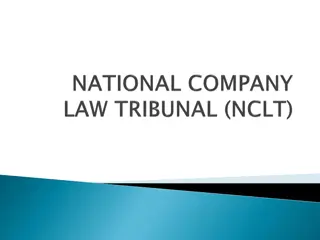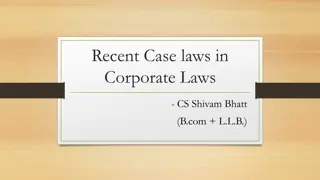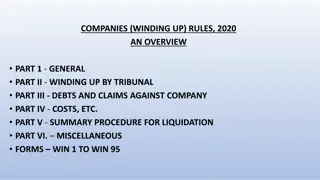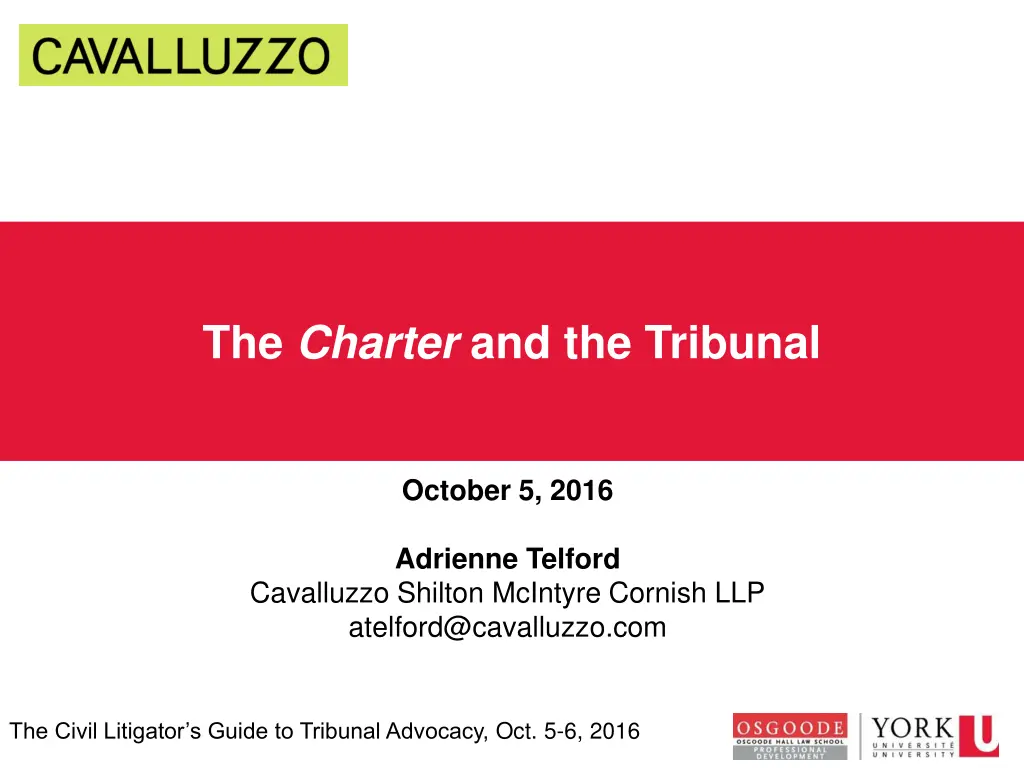
Understanding Tribunal Jurisdiction and Charter Issues
Explore the scope of a tribunal's charter jurisdiction, types of charter issues, remedies, and procedural considerations in this comprehensive guide. Learn about the benefits and drawbacks of tribunals in dealing with constitutional matters. Gain insights into how tribunals play a crucial role in upholding Charter rights and the expectations set by the Supreme Court of Canada.
Download Presentation

Please find below an Image/Link to download the presentation.
The content on the website is provided AS IS for your information and personal use only. It may not be sold, licensed, or shared on other websites without obtaining consent from the author. If you encounter any issues during the download, it is possible that the publisher has removed the file from their server.
You are allowed to download the files provided on this website for personal or commercial use, subject to the condition that they are used lawfully. All files are the property of their respective owners.
The content on the website is provided AS IS for your information and personal use only. It may not be sold, licensed, or shared on other websites without obtaining consent from the author.
E N D
Presentation Transcript
YOUR FIRM LOGO The Charter and the Tribunal October 5, 2016 Adrienne Telford Cavalluzzo Shilton McIntyre Cornish LLP atelford@cavalluzzo.com The Civil Litigator s Guide to Tribunal Advocacy, Oct. 5-6, 2016
Presentation Overview (1) Scope of a tribunal s Charter jurisdiction (2) Types of Charter issues that arise before a tribunal Validity of governing legislation Statutory aid to interpretation Limits on exercise of discretion Other issues (3) Charter remedies (4) Procedural issues - Notice - Formality of proceedings, evidentiary issues - Intervenors - Bifurcation
(1) Scope of a tribunals Charter jurisdiction Expansion of the role of administrative tribunals in interpreting and applying the Charter: The Charter is not some holy grail which only judicial initiates of the superior courts touch. The Charter belongs to the people. All law and law-makers that touch the people must conform to it. Tribunals and commissions charged with deciding legal issues are no exception. Many more citizens have their rights determined by these tribunals than by the courts. If the Charter is to be meaningful to ordinary people, then it must find its expression in the decisions of these tribunals. McLachlin CJ in Cooper v. Canada (Human Rights Commission), [1996] 3 SCR 854, para. 70 (dissenting) (aff'd in Nova Scotia (Workers' Compensation Board) v. Martin, [2003] 2 SCR 504, para. 29)
(1) Scope of a tribunals Charter jurisdiction Benefits Prevents bifurcated proceedings Promotes early and accessible adjudication of Charter rights Less expensive and time-consuming Specialized competence of tribunals is of invaluable assistance in constitutional interpretation A full record established by a specialized tribunal fully apprised of the policy and practical issues relevant to the Charter claim
(1) Scope of a tribunals Charter jurisdiction Drawbacks Lack of expertise Any gains in efficiency may be lost through judicial review Loose evidentiary rules of tribunals are unsuited to constitutional litigation Constitutional matters will bog down the tribunal system
(1) Scope of a tribunals Charter jurisdiction Bottom line SCC expects tribunals to apply the Charter to issues that arise in the proper exercise of their statutory functions This includes Charter issues falling within their specialized jurisdiction and also in exercising their statutory discretion in accordance with the Charter
(2) Types of Charter issues that arise before a tribunal (a) Validity of governing legislation (b) Statutory aid to interpretation (c) Limits on exercise of discretion (d) Other Charter issues
(a) Validity of governing legislation Nova Scotia (Workers Compensation Board) v. Martin, 2003 SCC 54 Constitutional challenge to a statutory provision 4 part test for determining tribunal s jurisdiction to determine constitutionality of legislative provisions (para. 48)
(a) Validity of governing legislation Nova Scotia (Workers Compensation Board) v. Martin Testsummarized in R v. Conway, [2010] 1 SCR 765 (para. 68): (1) Under the tribunal's enabling statute, does the administrative tribunal have jurisdiction, explicit or implied, to decide questions of law arising under a legislative provision? If so, the tribunal is presumed to have the jurisdiction to determine the constitutional validity of that provision under the Charter. (2) Does the tribunal's enabling statute clearly demonstrate that the legislature intended to exclude the Charter from the tribunal's jurisdiction? If so, the presumption in favour of Charter jurisdiction is rebutted.
(a) Validity of governing legislation Nova Scotia (Workers Compensation Board) v. Martin test Express jurisdiction: - Tribunal explicitly authorized to "determine all questions of fact and law - Tribunal's decisions could be appealed "on any question of law - Presumption that Tribunal authorized to decide Charter
(a) Validity of governing legislation Implied jurisdiction (para. 48): - statutory mandate of the tribunal and whether deciding questions of law is necessary to fulfilling this mandate - interaction of the tribunal with other elements of the administrative system - whether the tribunal is adjudicative in nature - practical considerations: the tribunal's capacity to consider questions of law. (However, practical considerations cannot override a clear implication from the statute itself.)
(b) Statutory aid to interpretation Only where there is a genuine ambiguity can Charter values play a role in statutory interpretation: . . . to the extent this Court has recognized a Charter values interpretive principle, such principle can only receive application in circumstances of genuine ambiguity, i.e., where a statutory provision is subject to differing, but equally plausible, interpretations. Bell ExpressVu Limited Partnership v. Rex, [2002] 2 SCR 559, para. 62
(b) Statutory aid to interpretation The presumption that a provision is consistent with Charter values only comes into play as an interpretive principle if the provision is genuinely ambiguous Prior to considering the Charter, the statute must be construed in the ordinary manner according to the modern approach to statutory construction
(b) Statutory aid to interpretation If statute is unambiguous, tribunal must give effect to the clearly expressed legislative intent and avoid using the Charter to achieve a different result Policy: upsetting the balance between the legislatures and the courts Bell ExpressVu, para. 66
(b) Statutory aid to interpretation What constitutes a genuine ambiguity? an ambiguity must be real . The words of the provision must be reasonably capable of more than one meaning . By necessity, however, one must consider the entire context of a provision before one can determine if it is reasonably capable of multiple interpretations. It is only when genuine ambiguity arises between two or more plausible readings, each equally in accordance with the intentions of the statute, that the courts need to resort to external interpretive aids , to which I would add, including other principles of interpretation . Bell ExpressVu, para. 29
(b) Statutory aid to interpretation ambiguity cannot reside in the mere fact that several courts -- or, for that matter, several doctrinal writers -- have come to differing conclusions on the interpretation of a given provision. Just as it would be improper for one to engage in a preliminary tallying of the number of decisions supporting competing interpretations and then apply that which receives the higher score , it is not appropriate to take as one s starting point the premise that differing interpretations reveal an ambiguity. It is necessary, in every case, for the court charged with interpreting a provision to undertake the contextual and purposive approach set out by Driedger, and thereafter to determine if the words are ambiguous enough to induce two people to spend good money in backing two opposing views as to their meaning . Bell ExpressVu, para. 30 [underlining in original]
(b) Statutory aid to interpretation High threshold for genuine ambiguity Taylor-Baptiste v. OPSEU, 2015 ONCA 495 Human rights complaint before HRTO regarding offensive blog posting made by union official S. 5(1) of the Human Rights Code with respect to employment is not genuinely ambiguous
(b) Statutory aid to interpretation High threshold for genuine ambiguity ONA and SEIU v. Participating Participating Nursing Homes, [2016] OPED No. 5 Tribunal: it is neither required nor appropriate to do so as the Act was not ambiguous (para. 140) Even though Tribunal itself stated that the provisions of the Act make for "difficult reading"
(b) Statutory aid to interpretation High threshold for genuine ambiguity ? R. v. Mabior, [2012] 2 SCR 584, para. 44: "Charter values are always relevant to the interpretation of a disputed provision of the Criminal Code.
(b) Statutory aid to interpretation R. v. Clark, 2014 SCC 28, para. 12-15 Sarnia (City) v. River City Vineyard Christian Fellowship of Sarnia, 2015 ONCA 494 Durham District School Board et al, 2015 CanLII 30160 (ON LRB), para. 91
(c) Limits on exercise of discretion The Charter applies to a statutory body, such as a tribunal, as part of the apparatus of government or as a delegate of statutory authority. P.W. Hogg, Constitutional Law of Canada, 5th ed., at 37.2(c)&(e) 32. (1) This Charter applies a) to the Parliament and government of Canada in respect of all matters within the authority of Parliament ; and b) to the legislature and government of each province in respect of all matters within the authority of the legislature of each province.
(c) Limits on exercise of discretion The Charter applies to a statutory body when it exercises its statutory discretion under its enabling legislation Slaight Communications Inc. v. Davidson, [1989] 1 SCR 1038, pp. 1077-79 Douglas/Kwantlen Faculty Assn. v. Douglas College, [1990] 3 SCR 570, pp. 584-85
(c) Limits on exercise of discretion R. v. Conway, [2010] 1 SCR 765, para. 78: Administrative tribunals "must act consistently with the Charter and its values when exercising their statutory functions.
(c) Limits on exercise of discretion Dor v. Barreau du Qu bec, [2012] 1 SCR 395 (1) guidance on how tribunals should apply Charter values in the exercise of statutory discretion; and (2) guidance for courts on judicial review of tribunal decisions.
(c) Limits on exercise of discretion Dor v. Barreau du Qu bec, [2012] 1 SCR 395 Applying Charter values in the exercise of statutory discretion (para. 56): (1) first consider the statutory objectives; and (2) then ask how the Charter value at issue will best be protected in view of the statutory objectives. This "requires the decision- maker to balance the severity of the interference of the Charter protection with the statutory objectives .
(c) Limits on exercise of discretion Dor v. Barreau du Qu bec, [2012] 1 SCR 395 Decision-making process is about ensuring "balance and proportionality". Tribunal must strike an appropriate balance between rights and objectives to ensure that the rights at issue are not unreasonably limited. Tribunal must ensure that any decision interferes with the relevant Charter guarantee no more than is necessary given the statutory objectives. (para. 6-7)
(c) Limits on exercise of discretion Dor v. Barreau du Qu bec, [2012] 1 SCR 395 Judicially reviewing tribunal decisions: deferential standard of review is consistent with Dunsmuir = reasonableness(para. 30) Must assess the adjudicative decision under the administrative law approach, not s. 1 Oakes analysis
(c) Limits on exercise of discretion Dor v. Barreau du Qu bec, [2012] 1 SCR 395 "In the Charter context, the reasonableness analysis is one that centres on proportionality, that is, on ensuring that the decision interferes with the relevant Charter guarantee no more than is necessary given the statutory objectives. If the decision is disproportionately impairing of the guarantee, it is unreasonable. If, on the other hand, it reflects a proper balance of the mandate with Charter protection, it is a reasonable one." (para. 7)
(c) Limits on exercise of discretion Dor v. Barreau du Qu bec, [2012] 1 SCR 395 BUT When a tribunal is determining the constitutionality of a law, the standard of review is correctness (Dunsmuir, para. 58; Dor , para. 43.)
(c) Limits on exercise of discretion Trinity Western University v. The Law Society of Upper Canada, 2016 ONCA 518 "On judicial review, the question becomes whether, in assessing the impact of the relevant Charter protection and given the nature of the decision and the statutory and factual contexts, the decision reflects a proportionate balancing of the Charter protections at play. (para. 65-69)
(d) Other Charter issues that may arise Tribunal has jurisdiction over government actors Eg. Police discipline cases, Security Intelligence Review Committee (CSIS) But beware: HRTO line of decisions limiting the ability of the Tribunal to directly challenge government action as violating the Charter Eg. R. C. v. District School Board of Niagara, 2012 HRTO 1591, para. 15 (& cases cited therein)
Tribunal has no jurisdiction Express denial of jurisdiction in enabling statute eg. Social Benefits Tribunal: explicit limit in statute providing that the Tribunal "shall not inquire into or make a decision concerning the constitutional validity of a provision of an Act or a regulation". eg. Health Services Appeal and Review Board, Consent and Capacity Board
Tribunal has no jurisdiction Express denial of jurisdiction in enabling statute? Martin v. Canada (Attorney General), 2013 FCA 15 Statute gave express jurisdiction to decide questions of law to Umpire but silent re Referee Board FCA: SCC decision in T treault-Gadoury applies notwithstanding Nova Scotia v. Martin, R. v. Conway, Dor
Tribunal has no jurisdiction Martin v. Canada (Attorney General), 2013 FCA 15 Because the Act affirmatively gives this responsibility to the Umpire, and is silent on the role of the Board with respect to questions of law, the necessary conclusion is that the Board does not have this authority. (para. 99) * Nb: statute has been amended since.
Tribunal has no jurisdiction Constitutionally challenging denial of jurisdiction? H.(E.) v. Ontario (General Manager, Health Insurance Plan), 2012 ONSC 5106 (Ont. Div. Ct.) Section 6(3) of Act the Board shall not inquire into or make a decision concerning the constitutional validity of a provision of an Act or a regulation .
Tribunal has no jurisdiction H.(E.) v. Ontario (General Manager, Health Insurance Plan), 2012 ONSC 5106 (Ont. Div. Ct.) Div. Ct. dismissed the challenge (para. 6-7): R. v. Conway recognized that the legislature may impose clear limits on a tribunal's jurisdiction. However, restrictions on constitutional jurisdiction ought to be narrowly interpreted.
Tribunal has no jurisdiction H.(E.) v. Ontario, para. 8 Section 6 (3) does not foreclose [the] ability to tender evidence or seek a remedy on the basis that individual Charter rights have been infringed by the application of the statutory and regulatory regime or [that the] policies of the respondent in withdrawing its funding are contrary to the Charter and invalid and of no effect. Section 6 (3) only forecloses inquiry into, or making a decision concerning, the constitutional validity of an Act or regulation.
Tribunal has no jurisdiction Tribunals typically do not have authority to decide stand-alone constitutional issues: MacLennan v. Ontario (Transportation), 2013 HRTO 714 HRTO has no jurisdiction over Charter challenge to provision in regulation not connected to Code But has jurisdiction over Charter challenge to provision in regulation that precludes the application of Code
(3) Charter remedies Section 24(1) of the Charter 24. (1) Anyone whose rights or freedoms, as guaranteed by this Charter, have been infringed or denied may apply to a court of competent jurisdiction to obtain such remedy as the court considers appropriate and just in the circumstances.
(3) Charter remedies R. v. Conway, [2010] 1 SCR 765 Is an administrative tribunal a court of competent jurisdiction ? Institutional as opposed to case-by-case approach
(3) Charter remedies R. v. Conway, [2010] 1 SCR 765 2 step analysis: (1) Does the administrative tribunal has jurisdiction, explicit or implied, to decide questions of law? If it does, and unless it is clearly demonstrated that the legislature intended to exclude the Charter from the tribunal's jurisdiction, the tribunal is a court of competent jurisdiction and can consider and apply the Charter and Charter remedies when resolving the matters properly before it.
(3) Charter remedies R. v. Conway, [2010] 1 SCR 765 (2) Can the tribunal can grant the particular remedy sought, given the relevant statutory scheme? - an exercise in discerning legislative intent - whether the remedy sought is the kind of remedy that legislature intended would fit within the statutory framework of the particular tribunal - Relevant considerations: those that have guided the courts in past cases, such as the tribunal's statutory mandate, structure and function (Dunedin).
(3) Charter remedies s. 24(1) Remedies Chaudry (Re), 2015 ONCA 317 Ontario Review Board does not have jurisdiction to award costs as s. 24(1) remedy Starz (Re), 2015 ONCA 318 Ontario Review Board does not have jurisdiction to award costs, damages or declaratory relief as s. 24(1) remedies
(3) Charter remedies s. 24(1) Remedies Chaudry (Re) and Starz (Re) Detract from the Board s ability to meet its statutory mandate and functions Heighten adversarial tenor of proceedings Prolong hearings Board s role focused on individual not systemic Charter rights vindicated through exercise of statutory powers and processes
(3) Charter remedies s. 52(1) of Constitution Act, 1982 52. (1) The Constitution of Canada is the supreme law of Canada, and any law that is inconsistent with the provisions of the Constitution is, to the extent of the inconsistency, of no force or effect.
(3) Charter remedies s. 52(1) of Constitution Act, 1982 Tribunal cannot make a general declaration of invalidity; it may treat an impugned provision as invalid for the purposes of the matter before it. Cuddy Chicks Ltd. v. Ontario (Labour Relations Board), [1991] 2 SCR 5, p. 17 RE Starz, 2015 ONCA 318 para. 106 et seq.
(3) Charter remedies s. 52(1) of Constitution Act, 1982 Decision No. 1945/10, 2015 ONWSIAT 223 Tribunal followed earlier decision of Tribunal on same issue (Charter challenge to statutory provision) Declined to apply the impugned provision in the proceedings before it on basis of previous finding of unconstitutionality
(4) Procedural issues (a) Notice (b) Formality of proceedings, evidentiary issues (c) Intervenors (d) Bifurcation
(4) Procedural issues (a) Notice Of Constitutional Question Section 109 of the Courts of Justice Act 109. (1) Notice of a constitutional question shall be served on the Attorney General of Canada and the Attorney General of Ontario in the following circumstances: 1. The constitutional validity or constitutional applicability of an Act of the Parliament of Canada or the Legislature, of a regulation or by- law made under such an Act or of a rule of common law is in question. 2. A remedy is claimed under subsection 24 (1) of the Canadian Charter of Rights and Freedoms in relation to an act or omission of the Government of Canada or the Government of Ontario.
(4) Procedural issues Section 109 of the Courts of Justice Act cont d: (6) This section applies to proceedings before boards and tribunals as well as to court proceedings. See also Rule 4.11 of the Rules of Civil Procedure, R.R.O. 1990, Regulation 194, which provides that notice of a constitutional question shall be made with Form 4F.






